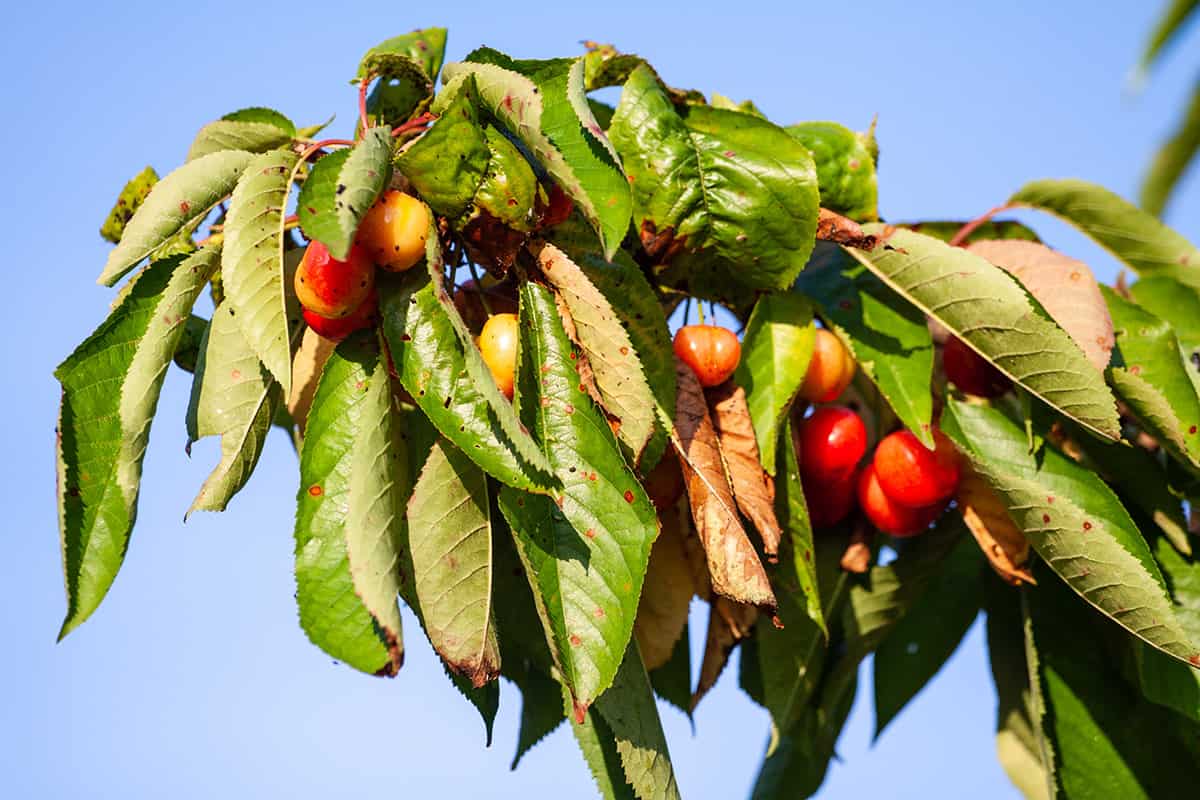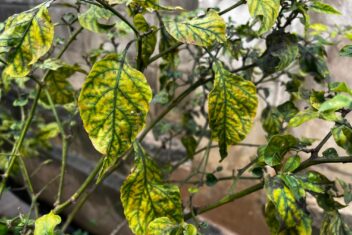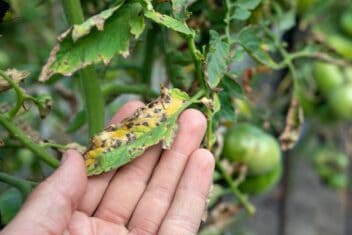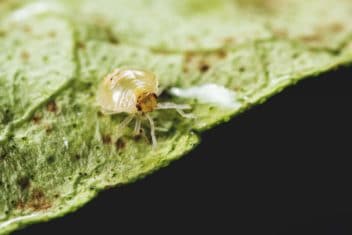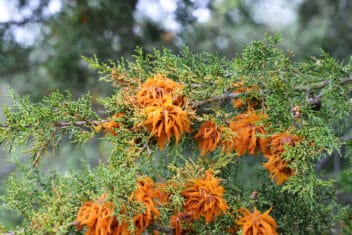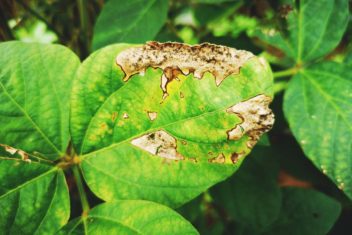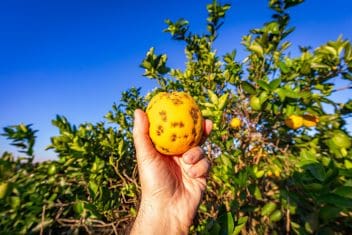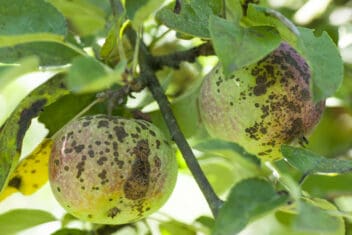Cherry trees are one of the easiest fruits to grow in your backyard, but that doesn’t mean they’re without problems. Sadly, it’s not unusual to come out to check in your trees, only to discover one of many possible cherry tree pests and diseases.
More than humans love the tasty cherries; pests and diseases find the trees to be a nutritious source of food. You have to know what potential issues you might run into in order to prevent them from attacking.
Here are some of the most common cherry tree pests and diseases.
5 Cherry Tree Pests
There are a few pests that attack stone fruit trees, some of which only attack cherries. Most can be controlled with some basic measures.
1. Aphids

One of the most common cherry tree pests are aphids, which are small, soft-bodied insects that live on the underside of leaves and the stems of your tree. Most aphid infestations aren’t serious, but a heavy infestation causes yellowing leaves and necrotic spots on the leaves.
One of the biggest problems with aphids is that they suck out the sap from your plants and secrete a sugary substance called honeydew all over your plants. Honeydew attracts sooty mold, another problem you don’t want in your cherry trees. They can also spread disease.
Take a look at our guide to aphids to learn more.
2. European Cherry Fruit Fly
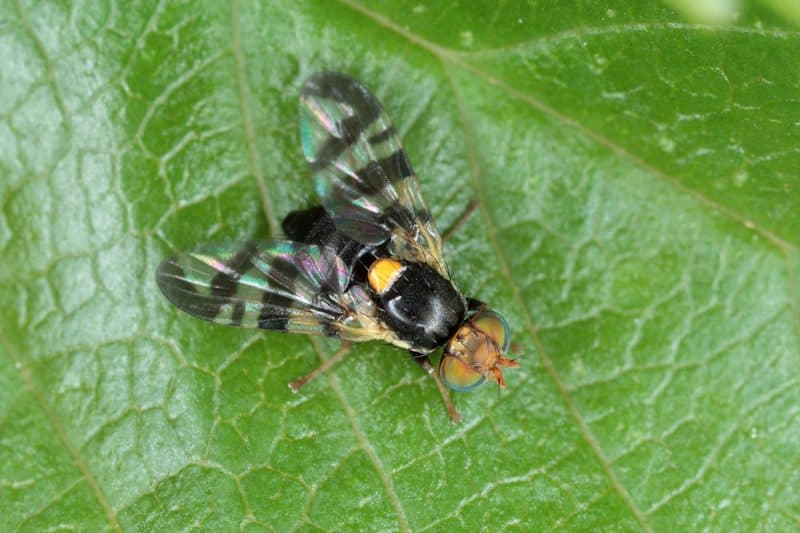
Adult cherry fruit flies (Rhagoletis cerasi) look similar to a housefly but much smaller, and with stripes on their wings. The larvae look like yellowish-white grubs. These pests cause small, pinpoint sting marks on the cherry fruit surfaces, and the adults lay eggs under the fruit skin. Then, they hatch and the larvae tunnel through the fruits.
Hang traps in your cherry trees to lure the adults. There are also natural fruit tree sprays that treat cherry fruit flies, but you want to be sure to rotate which one you use to prevent the flies from developing resistance. Check with your local extension office to see what is recommended in your area.
3. Peach Twig Borer
Even though these are called peach twig borers, they can infest your cherry trees. They cause the death of the shoot tips and the feeding damages the fruit, typically at the stem end. Peach twig borers overwinter in the bark and crotch of the limbs of your tree, making it hard to get rid of them.
The best way to eliminate peach twig borers is to use well-timed applications of insecticides when the cherry trees start to bloom. Bacillus thuringiensis is quite effective against this pest, but infestations may also be treated with organophosphate or pyrethroid insecticides.
4. Spider Mites
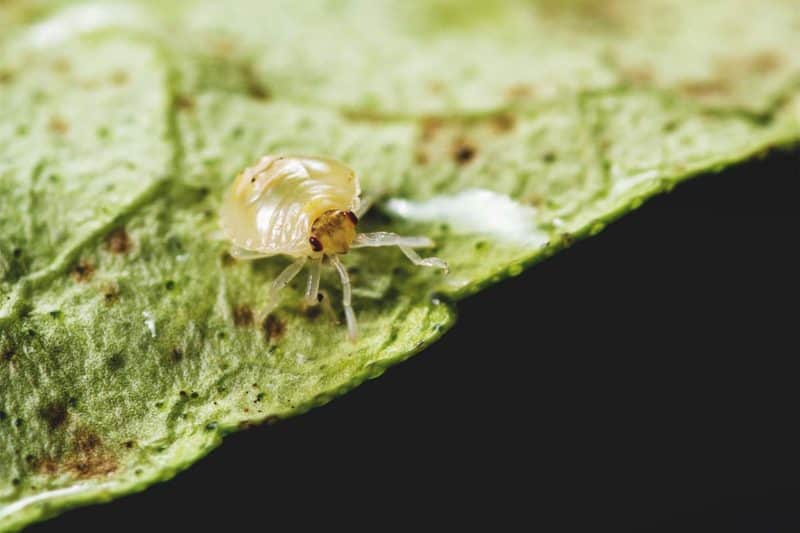
Spider mites are part of the arachnid family. They suck on plants and cause the leaves to become stippled with yellow, or they might have a bronzed appearance. Spider mites leave behind a webbing that covers the leaves, and that’s probably what you’ll notice first since they’re so small that you typically need a hand lens to see them.
The mites look like tiny, moving dots on the webs, but they might also be on the undersides of the leaves. Applying insecticidal soap or horticultural oils helps to get rid of spider mites; chemical insecticides aren’t recommended because they kill off natural enemies that kill off the spider mites.
Our guide to spider mites can help you get the situation under control.
5. Western Cherry Fruit Fly
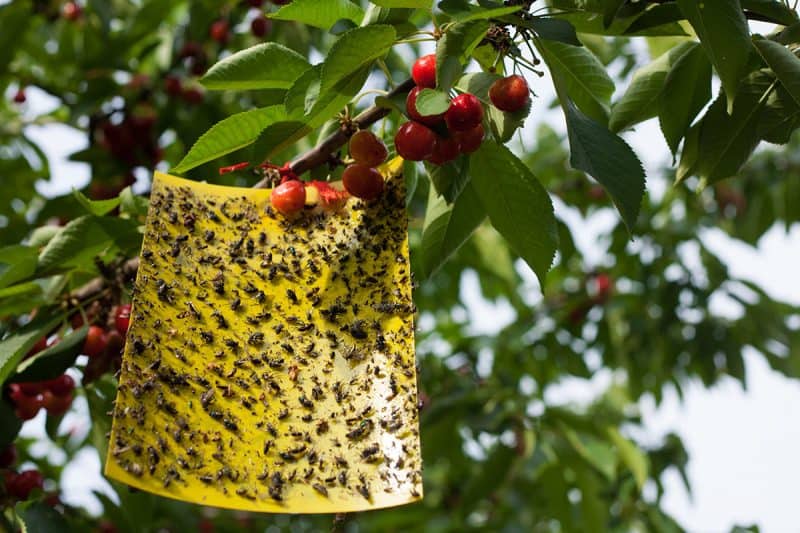
No one wants to find western cherry fruit flies (Rhagoletis indifferens) on their cherry trees. The adults fly around and lay eggs in the cherries, typically choosing the damaged ones to attack. The larvae develop inside the cherries and cause the fruits to become mushy, destroying them. The pests are known for causing serious damage in the western part of the US.
Western cherry fruit flies can be trapped with yellow sticky traps, and traps that contain lures with ammonium carbonate are most effective. You also can use chemical treatments to target egg-laying females. There are several recommended sprays that you can use at home, such as spinosad, malathion, and acetamiprid.
7 Cherry Tree Diseases
Pay attention when you grow cherry trees and keep a close eye out for any of these diseases. Early treatment helps to stop the spread of the problem; don’t let it get away from you!
1. Bacterial Canker
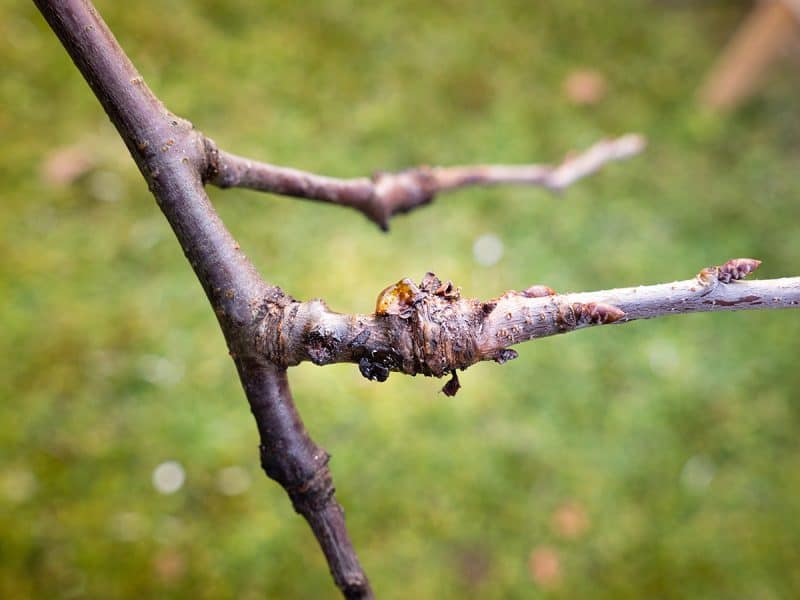
Bacterial canker is a bacterial disease that causes cankers on the twigs at the base of the flower and leaf buds. These cankers spread upward and form sunken areas in the winter. Typically, the disease starts in the spring, killing the plant by the time summer rolls around.
It prefers to grow when there are low temperatures and a lot of moisture, making spring the ideal time for growth. Growing trees developed for your area helps to reduce the risk of contracting bacterial canker, and you can apply a protective layer of a copper spray to the trees before flowering. Yearly pruning also helps to reduce the likelihood of infection.
2. Black Knot
Black knot is a cherry tree fungal disease that causes elongated swellings on the woody parts of the tree. It’s easy to spot the knots; they typically start off as olive green in color with a corky texture but eventually turn black. These black knot infections occur on new shoots after rainfall.
If you suspect that your cherry trees have black knot, prune the knots off the twigs and branches, and immediately put them in the trash. Don’t put them in the compost or leave them on the ground. Removal of the knots is the most effective way to get rid of this disease, but controlled applications of fungicides will help as well.
3. Brown Rot
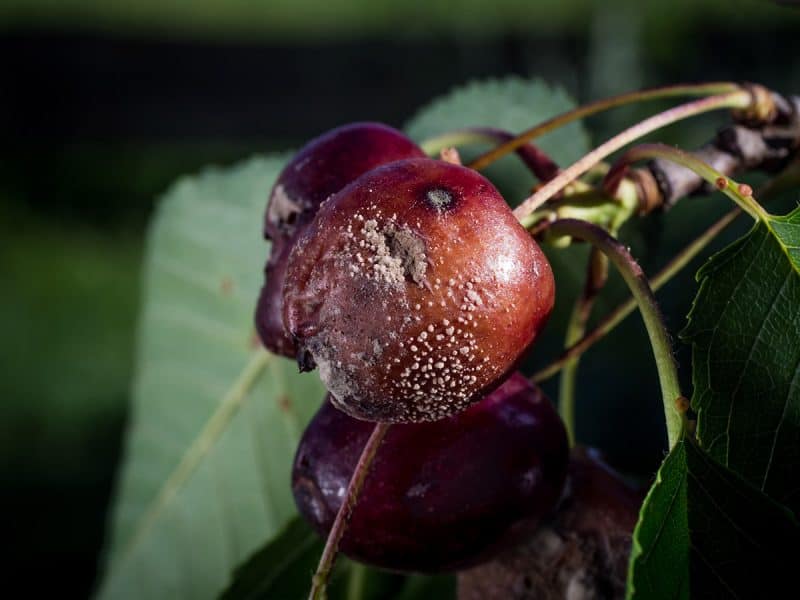
Brown rot causes the brown discoloration of fruit skin and inner tissue, and the cherry skin might wrinkle. It leads to tan cankers with dark edges and gray-brown spores on the skin.
The fungus lives on the mummified fruit on the trees, blossoms, and twigs. The best way to take care of this fungal disease is to use appropriate protective fungicides timed so that they’re applied when the flower parts are open. You also need to practice good cultural control methods, like removing mummified fruits from the tree, pruning off the infected twigs, and giving the tree enough water and fertilizer.
4. Cherry Leaf Spot
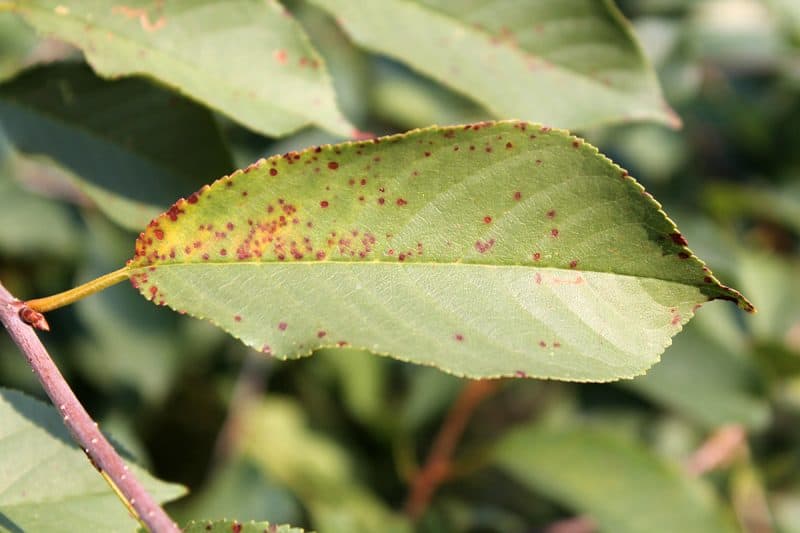
Cherry leaf spot is a fungus (Blumeriella jaapii) that causes the development of small, red-purple spots on the upper surfaces of the cherry tree leaves. Eventually, they turn brown, and the leaves may become chlorotic if there are lesions present. Severe infections cause the fruit to fail to develop.
This fungus overwinters on infected leaves on the ground, and it prefers to grow in warm temperatures with high humidity. The best way to tree cherry leaf spot is to make appropriate applications of fungicides; there aren’t any varieties resistant to this disease.
5. Powdery Mildew
One of the most common cherry tree diseases is powdery mildew, causing circular lesions on the leaves that develop a powdery appearance. In severe cases, the leaves blister and the infected shoots become distorted and stunted. You might notice that the infections happen when there is more rainfall, since it is spread via water.
Powdery mildew is treatable with appropriate fungicides. Take a look at our guide to powdery mildew in the garden to find out more ways to handle this disease.
6. Silver Leaf
Silver leaf causes the leaves to have a silvery appearance, and the leaves might curl upwards, becoming necrotic. This fungal infection causes the death of individual limbs or the entire tree.
This pathogen spreads through the spores after the rainfall and are released during periods of humidity, and it enters the trees through wounds caused by pruning or damage. When you prune trees in the late winter or early spring, it increases the risk of infection.
Silver leaf control is difficult because it spreads after rainfall. You can use strategies to reduce the diseases like removing all the plant debris, pruning logs, pruning the tree during dry periods, and treating large wounds with fungicidal dressings.
7. Verticillium Wilt
One of the worse fungal infections that your cherry trees can contract is verticillium wilt. It causes withering of the leaves on the spurs of one-year-old wood, and the leaves end up dull and stunted. Unfortunately, older cherry trees don’t recover from this disease, but keeping the younger trees adequately fertilized and watered helps them survive.
Take a look at our guide to verticillium wilt to learn more about this disease.
